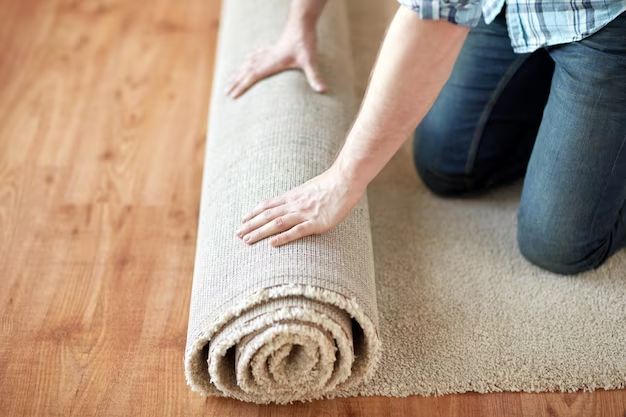Having a carpet that has started to pull up or separate from the floor can be an annoying and potentially dangerous issue. Luckily, there are some simple steps you can take to reattach the carpet and smooth it back down.
Page Contents
- 1 What causes carpet to pull up or separate from the floor?
- 2 How to reattach pulled up carpet
- 2.1 Step 1: Lift the pulled up section
- 2.2 Step 2: Check for moisture
- 2.3 Step 3: Scrape off old adhesive
- 2.4 Step 4: Re-activate adhesive
- 2.5 Step 5: Apply new adhesive
- 2.6 Step 6: Smooth carpet into adhesive
- 2.7 Step 7: Seal edges
- 2.8 Step 8: Weigh down repaired section
- 2.9 Step 9: Stretch and secure carpet
- 3 Tips for preventing carpet from pulling up
- 4 When to call a professional
- 5 The costs of professional carpet repair
- 6 Conclusion
What causes carpet to pull up or separate from the floor?
There are a few common causes for carpet pulling up or losing adhesion to the floor:
- Improper installation – If the carpet was not stretched and secured properly when it was originally installed, it may start to loosen and detach over time.
- Excessive moisture – Spills, flooding, or high humidity can cause the carpet backing or padding to expand. This expansion can loosen the carpet.
- Heavy furniture – The weight of heavy furniture can crush the carpet and detach it from the floor beneath.
- Excessive traffic – In high traffic areas, the constant pounding of feet can cause the carpet to loosen and pull up.
- Improper tack strips – If tack strips at the edges are damaged or installed incorrectly, the carpet can detach at the edges first.
How to reattach pulled up carpet
If you’re dealing with pulled up carpet, here are some step-by-step instructions for fixing it:
Step 1: Lift the pulled up section
Carefully lift the detached section of carpet so it is raised slightly off the floor, but do not pull too hard or you may damage the carpet. Use a pry bar or putty knife to help lift carpet edges.
Step 2: Check for moisture
Examine the underside of the carpet and the floor beneath for any signs of moisture or water damage. Wet carpet backing will need to dry completely before attempting to reattach.
Step 3: Scrape off old adhesive
Use a scraper or putty knife to remove any remaining stuck-on carpet adhesive from the floor. Scrape until you reach a smooth, clean surface.
Step 4: Re-activate adhesive
For carpets installed with a releasable adhesive, you can re-activate the glue by applying warm water. Use a spray bottle to lightly mist the adhesive layer, allow it to soak in for 60-90 seconds, then press carpet back into place.
Step 5: Apply new adhesive
For permanent glues or areas where adhesive pulled up, apply new all-purpose carpet adhesive. Use a notched trowel to spread adhesive evenly over the floor section, following the adhesive directions.
Step 6: Smooth carpet into adhesive
Once adhesive is prepared, carefully lower lifted edges of carpet into adhesive and press down firmly. Use a carpet kicker tool to help smooth out any air pockets or bumps.
Step 7: Seal edges
Use carpet seam tape or edge sealer adhesive along trimmed edges to prevent further unraveling or detachment. Press sealer into place firmly.
Step 8: Weigh down repaired section
Place heavy weights, like books or boxes of tile, evenly over the reattached carpet area. This applies pressure as adhesive dries for a stronger bond.
Step 9: Stretch and secure carpet
Once adhesive has dried, use a power carpet stretcher tool to pull and re-stretch the carpet for a smooth, snug fit. Secure edges with tack strips if needed.
Tips for preventing carpet from pulling up
To help prevent carpet from detaching again in the future, keep these tips in mind:
- Have your carpet professionally stretched every 1-2 years to maintain tension.
- Keep furniture legs covered with felt pads to prevent crushing.
- Limit direct sunlight exposure which can degrade carpet adhesives.
- Clean up spills immediately to prevent moisture issues.
- Consider low-VOC carpet tiles for easy replacement of damaged sections.
- Use carpet protector mats in high-traffic areas.
When to call a professional
While minor pulled up carpet can be repaired DIY, it’s best to call a professional installer for the following issues:
- Large sections are detached, over 25% of a room
- Severe buckling or ripples in the carpet
- Significant pet urine or water damage
- Carpet seam is coming apart
- You don’t have the proper tools or feel uncomfortable making the repair
Professionals have the skills, tools, and supplies for seam repairs, advanced stretching, carpet disposal, and replacing badly damaged sections. They can also determine and fix the underlying issue, so carpet won’t detach again.
The costs of professional carpet repair
If you do need to hire a pro for pulled up carpet issues, here are average costs:
| Service | Average Cost |
| Basic re-stretching | $250+ |
| Repair pulled up section | $100 – $300 |
| Seam repair | $200 – $400 |
| Carpet patching | $300+ per patch |
| Full carpet replacement | $1,500+ |
Get an estimate upfront before hiring a carpet company. Rates vary greatly based on your location, carpet material, size of repair, and technicians.
Conclusion
Pulling up or detaching is a common issue that happens to even professionally installed carpets over time. With some basic tools and DIY skills, minor pulled carpet can be smoothed out and reattached successfully. For bigger repairs, hire a trusted pro to fix it properly. With the right care, your carpet can look great and stay put for years before needing full replacement.
